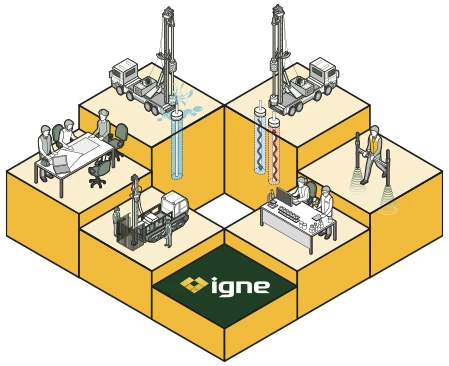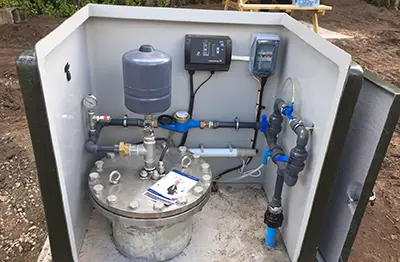

Caliper Measurement Logging
Caliper logging is a simple, yet powerful, geophysical tool used to measure the internal diameter of a borehole along its entire depth.
About
Caliper Logging
Caliper logging is a crucial pre-requisite for further geophysical logging, as not only can it identify potential borehole collapse, it can also confirm data validity, as geophysical data may not be able to be collected in problematic areas.
By providing a continuous profile of the borehole wall, it helps detect zones of collapse, over-drilling, scaling, bridging, or other structural changes that could affect the safety, performance or lifespan of a borehole.
At Igne, we use high-resolution caliper tools as part of our borehole geophysics and diagnostic services. Caliper logs are frequently combined with CCTV and other geophysical logs to give a full picture of the borehole’s structural condition - particularly before pump installation, screen design or borehole rehabilitation.

The Measurements
What Does Caliper Logging Measure?
Caliper tools use spring-loaded mechanical arms or electronic sensors to record the diameter of the borehole at regular depth intervals. The resulting log shows variations in borehole shape, revealing:
- Enlarged zones (e.g. caused by over-drilling or formation washout)
- Collapsed or unstable areas
- Bridging or infill zones where material has slumped or compacted
- Scale or mineral deposit build-up on casing or screens
- Changes in borehole condition over time (comparison with previous logs)
The uses
When & Why Use Caliper Logging?
Caliper measurement is a valuable tool in a wide range of situations:
- Prior to pump or instrumentation installation
- When designing borehole casing or screens
- As part of a maintenance or rehabilitation programme
- To confirm borehole condition following drilling or cleaning
- To investigate performance issues or flow restrictions
- For QA/QC during construction handover or compliance checks
A caliper log provides an immediate, live and accurate record of borehole geometry, supporting safe and effective equipment installation and long-term borehole health.
The process
How Caliper Measurement Logging Works
The caliper probe is lowered into the borehole on a wireline. The tool is run to the bottom of your borehole, the arms are opened. As the tool is pulled out of the hole, the arms expand and retract in response to changes in borehole diameter. The tool continuously records these movements, producing a log showing borehole diameter by depth.
Some tools also record 3-arm or 4-arm cross-sectional data for enhanced accuracy.
Caliper logging is almost always run in conjunction with CCTV, gamma, or conductivity logs to build a complete borehole condition profile.
FAQ
Frequently Asked Questions about Caliper Measurement Logging
- What size boreholes can be logged with a caliper tool?
We can log most standard borehole sizes, from narrow monitoring wells to large-diameter abstraction wells. A standard caliper can measure from ~30mm to 500mm in diameter, but longer arms and more suitable tools can be provided.
- Is caliper logging suitable for cased boreholes?
Yes, especially if casing integrity or scale build-up is in question. Caliper logs can help assess internal corrosion, deformation, or obstructions
- What causes borehole diameter to change?
Common reasons include borehole collapse, unconsolidated formations, scaling, mineral precipitation, or erosion during drilling.
- How accurate is the caliper measurement?
High-resolution tools provide accuracy to within millimetres. Our equipment is regularly calibrated, and calibrations are verified before every project. Post logging, data is reviewed as part of our QA process.
- Is caliper logging destructive or invasive?
No, not at all, it’s a non-destructive method that simply tracks the shape of the borehole using mechanical arms or sensors. It has no impact on the borehole itself.
- Do I need to clean the borehole before caliper logging?
A clean borehole allows for better accuracy, especially if scaling or debris is present. In some cases, brushing or surging may be advised before logging.
The next step
Here to help
If you’re installing pumps, lining a borehole or troubleshooting performance issues, caliper measurement helps you work with confidence and avoid costly surprises down the line.
Get in touch with Igne today to book a borehole geometry survey and see your borehole from the inside out!


Temperature & Conductivity Logging

Flowmeter Logging

Caliper Measurement Logging

Dual Focused Resistivity Logging

